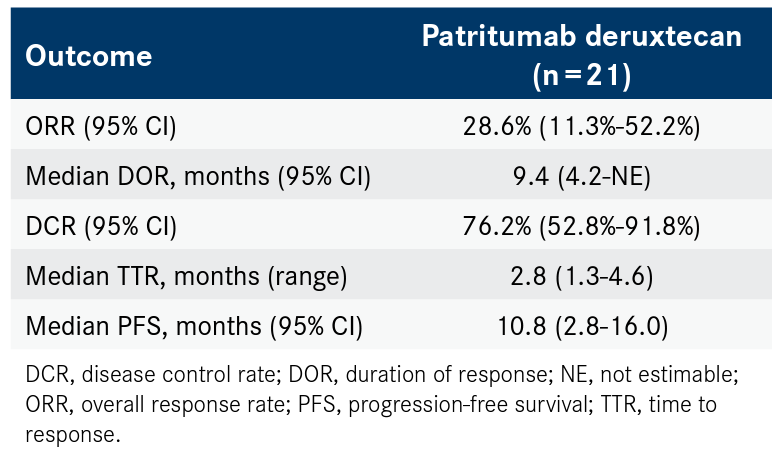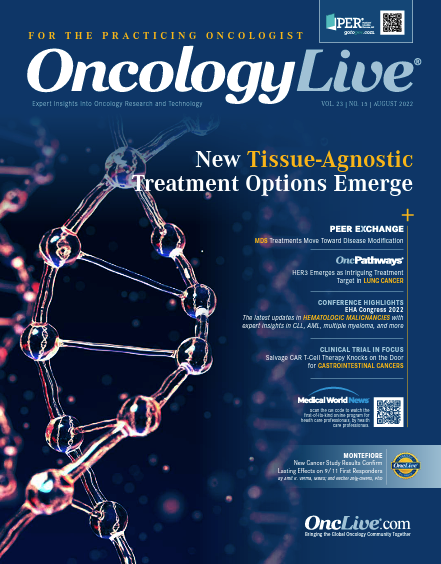HER3 Emerges as Intriguing Treatment Target in Lung Cancer
HER3 has been shown to have a small amount of tyrosine kinase activity, making it an attractive target for the treatment of patients who have progressed after treatment with tyrosine kinase inhibitors. Preclinical data have shown that targeting HER3 and EGFR can overcome acquired resistance to EGFR inhibition.
Joel Neal, MD, PhD

Recent research has thrust HER3 into the spotlight as a potentially effective therapeutic target for patients with lung cancer for whom limited treatment options exist. HER3 is overexpressed in upward of 40% of patients with lung cancer, including approximately 83% of patients with non–small cell lung cancer (NSCLC), and is associated with poor clinical outcomes.1,2
HER3 is a heterodimeric partner for EGFR and HER2. Additionally, HER3 expression contributes to metastatic development and resistance to EGFR-directed therapies, according to retrospective datasets.3
“EGFR and HER2 are both tyrosine kinases [that] need signaling through HER2 for dimerization and cross-phosphorylation to activate downstream, at least in the native forms of the protein—the ones activated by exogenous ligands,” Joel Neal, MD, PhD, an associate professor of medicine, oncology, at the Stanford Cancer Institute in Palo Alto, California, said during an OncLive® scientific interchange and workshop. “HER2 is important in EGFR-mutant lung cancer, but you can bypass some of that signaling and activate the PI3 kinase and AKT signaling pathways. Both of those [must] be activated for cell growth to happen in an oncogenic way. That heregulin-combined HER3, and then HER2 and HER3, can heterodimerize and bypass EGFR.”
Interestingly, HER3 has been shown to have a small amount of tyrosine kinase activity. This makes it an attractive target for the treatment of patients who have progressed after treatment with tyrosine kinase inhibitors (TKIs), for whom there are currently limited treatment options beyond chemotherapy. Preclinical data have shown that targeting HER3 and EGFR can overcome acquired resistance to EGFR inhibition.3
Novel HER3-Targeted Agent Makes an Impression in NSCLC
There are no HER3-directed agents approved by the FDA for the treatment of patients with lung cancer. For patients with EGFR-mutated NSCLC who have progressed after treatment with EGFR TKIs and chemotherapy, limited treatment options are available. However, patritumab deruxtecan (formerly U3-1402), a novel antibody-drug conjugate consisting of a fully humanized anti-HER3 IgG11 monoclonal antibody, has shown promise in the space.4
The monoclonal antibody is covalently linked to a topoisomerase I inhibitor payload via a tetrapeptide cleavable linker. The agent’s design is similar to that of fam-trastuzumab deruxtecan-nxki (Enhertu), another antibody-drug conjugate consisting of a deruxtecan-based topoisomerase I payload.4
The ongoing phase 1 U31402-A-U102 trial (NCT03260491) is evaluating patritumab deruxtecan in patients with locally advanced or metastatic NSCLC with and without identified driver genomic alterations. The dose-escalation and dose-expansion study enrolled patients with EGFR-mutant disease, as well as patients with non-EGFR oncogenic alterations if they had undergone at least 1 prior treatment with targeted therapy, if available.1,4
In the dose-escalation portion of the trial, patients received patritumab deruxtecan once every 3 weeks at a dose of 3.2 mg/kg (n = 4), 4.8 mg/kg (n = 15), 5.6 mg/kg (n = 12), or 6.4 mg/kg (n = 5). The recommended dose level for the dose expansion portion was determined to be 5.6 mg/kg.
In a pooled analysis of efficacy-evaluable patients with disease harboring an EGFR mutation who received the recommended dose in the dose-expansion or dose-escalation portion of the trial (n = 57), the overall response rate (ORR) was 39% (95% CI, 26.0%-52.4%), including 1 complete response. The disease control rate (DCR) was 72% (95% CI, 58.5%-83.0%). At a median follow-up of 10.2 months (range, 5.2-19.9), the median progression-free survival (PFS) was 8.2 months (95% CI, 4.4-8.3) and the median duration of response (DOR) was 6.9 months (95% CI, 3.1-not estimable [NE]).4
Notably, a subgroup of efficacy-evaluable patients who previously received prior platinum-based chemotherapy and third-generation EGFR TKI osimertinib (Tagrisso; n = 44) also achieved an ORR of 39% (95% CI, 24.4%-54.5%), with 1 patient experiencing a complete response. The DCR was 68% (95% CI, 52.4%-81.4%) and the median DOR was 7.0 months (95% CI, 3.1-NE).
The median age of patients included in the efficacy analysis was 66 years (range, 40-80). The population was heavily pretreated, with a median of 4 (range, 1-9) prior lines of therapy. All patients included in the trial underwent prior EGFR TKI therapy.
Regarding safety, all patients treated at the recommended dose level experienced a treatment-emergent adverse effect (TEAE). Common TEAEs of grade 3 or higher included thrombocytopenia (30%), neutropenia (19%), and fatigue (14%). TEAEs associated with treatment discontinuation occurred in 11% of patients, and TEAEs associated with death were reported in 7% of patients.
Interstitial lung disease, which was previously identified in other studies of trastuzumab deruxtecan as an important risk for this type of agent, was confirmed by an independent adjudication committee in 5 patients. Adjudicated treatment-related interstitial lung disease was reported in 4 patients: two grade 1, one grade 2, and one grade 3.
In December 2021, patritumab deruxtecan was granted breakthrough therapy designation by the FDA for the treatment of patients with metastatic or locally advanced NSCLC harboring an EGFR mutation, following disease progression after treatment with a TKI and platinum-based chemotherapy.5
Updated findings from the trial that included patients without EGFR mutations were presented at the 2022 American Society of Clinical Oncology Annual Meeting.1 At a median follow-up of 19.7 months (range, 13.8-29.2), patients with identified driver genomic alterations (n = 21) achieved an ORR of 28.6% (95% CI, 11.3%-52.2%). The DCR was 76.2% (95% CI, 52.8%-91.8%) and the median time to response (TTR) was 2.8 months (range, 1.3-4.6). The median DOR was 9.4 months (95% CI, 4.2-NE) and the median PFS was 10.8 months (95% CI, 2.8-16.0) (Table).1
Table. Updated Analysis of U31402-A-U1021

Similarly, among patients without any identif ied driver genomic alterations (n = 26), the ORR was 26.9% (95% CI, 11.6%-47.8%) and the DCR was 73.1% (95% CI, 52.2%-88.4%). Additionally, the median DOR was 9.6 months (95% CI, 1.6-NE) and the median PFS was 4.2 months (95% CI, 2.5-10.8).1 Patients in both groups were treated with patritumab deruxtecan 5.6 mg/kg intravenously once every 3 weeks.
In terms of safety, 5 patients in the safety population (n = 47) experienced a TEAE associated with treatment discontinuation and there were no drug-related deaths. The most common grade 3 or greater TEAEs included neutropenia (26%), fatigue (17%), thrombocytopenia (15%), and hypokalemia (13%). Any-grade drug-related interstitial lung disease was reported in 5 patients, with a median time to onset of 140 days (range, 43-331).
Targeting HER3: Next Steps
Neal noted that more data will be needed before HER3 can be fully established in the space. “For HER3, I want to see a predictive biomarker, [and] we don’t have a lot of data [on] HER3 [immunohistochemistry] right now, or H-scores or any of the [other tests],” he said. “If we could see what the predictive biomarker is, [then] ideally we’d like to personalize therapy of resistance of after first-generation EGFR/TKIs. Once we can personalize a little bit, we [can] see [whether] there are dominant mechanisms of resistance or drugs that work across [patients] regardless [of expression]. Then we’ll probably start to move those [agents] into the first-line setting.”
He added that understanding more about the biology of HER3 and whether it is critical to the cell function will inform investigators about whether there’s a role for it moving forward. “[Right now, it appears agents] can destroy HER3 on most lung cancer cells and destroy it in many other parts of the body and not have horrible toxicity,” Neal said. “But are we doing more than just destroying some cells that happen to express HER3? Does EGFR happen to express more of HER3 in a way that’s biologically dependent for the EGFR? Or is it just like CEACAM5 in that it may happen to be around cancer cells? I want to see a high-resolution picture of the cell, with exactly where the HER3 molecules are on the outside.”
In light of the robust findings from the U31402A-U102 trial, investigators have initiated the phase 2 HERTHENA-Lung01 trial (NCT04619004) to further evaluate patritumab deruxtecan. HERTHENA-Lung01 is a randomized, open-label trial that will enroll approximately 420 patients with metastatic or locally advanced NSCLC harboring an activating EGFR mutation. Eligible patients must also have progressed during or after treatment, with at least 1 EGFR TKI and at least 1 platinum-based chemotherapy regimen.6
Patients will be randomly assigned 1:1 to receive either a fixed-dose regimen of patritumab deruxtecan 5.6 mg/kg or patritumab deruxtecan via an up-titration dose regimen. In the up-titration arm, patients will be treated at a dose of 3.2 mg/kg in cycle 1, 4.8 mg/kg in cycle 2, and 6.4 mg/kg in cycle 3 and beyond.
The primary end point is ORR by blinded independent central review (BICR). Secondary end points include DOR, PFS, ORR by investigator assessment, DCR, and TTR. The study is presently enrolling patients and has an estimated completion date of 2023.
Additionally, patritumab deruxtecan is under investigation in combination with osimertinib among patients with advanced or metastatic NSCLC with an EGFR-activating mutation who have progressed during or after treatment with osimertinib in a phase 1 clinical trial (NCT04676477). The trial will enroll approximately 252 patients and will consist of dose escalation and dose expansion parts.7
During the dose escalation portion of the trial, patients will receive 1.6 mg/kg, 3.2 mg/kg, 4.8 mg/kg, or 5.6 mg/kg of patritumab deruxtecan intravenously every 3 weeks, plus osimertinib 40 mg or 80 mg orally once daily. Patients will be assigned to a given cohort via a Bayesian logistic regression model. The primary objectives of the dose escalation portion are evaluating the safety and tolerability of the combination and to identify a recommended dose.
If investigators find that the recommended dose includes daily osimertinib 80 mg, approximately 30 patients with advanced, treatment-naïve EGFR-mutant NSCLC will be enrolled in a separate cohort and treated at the recommended combination dose. The primary objective in this cohort will be safety and tolerability.
In the dose expansion part, patients will be randomly assigned 1:1 to be treated with patritumab deruxtecan plus osimertinib at the recommended combination dose or patritumab deruxtecan monotherapy at a dose of 5.6 mg/kg intravenously every 3 weeks. An additional arm could be added by investigators to evaluate 2 provisional recommended doses of the combination. Each arm will consist of approximately 60 patients. The primary objective of the dose expansion portion is to compare the efficacy of the combination with that of patritumab deruxtecan monotherapy.
The primary end point of the trial is ORR by BICR. Secondary end points include ORR by investigator, DOR, DCR, TTR, PFS, and overall survival.
References
- Steuer CE, Hayashi H, Su WC, et al. Efficacy and safety of patritumab deruxtecan (HER3-DXd) in advanced/metastatic non-small cell lung cancer (NSCLC) without EGFR-activating mutations. J Clin Oncol. 2022;40(suppl 16):9017. doi:10.1200/JCO.2022.40.16_suppl.9017
- Yonesaka K. HER2-/HER3-rargeting antibody-drug conjugates for treating lung and colorectal cancers resistant to EGFR inhibitors. Cancers (Basel). 2021;13(5):1047. doi:10.3390/cancers13051047
- Manickavasagar T, Yuan W, Carreira, et al. HER3 expression and MEK activation in non-small-cell lung carcinoma. Lung Cancer Manag. 2021;10(2):LMT48. doi:10.2217/lmt-2020-0031
- Jänne PA, Baik C, Su WC, et al. Efficacy and safety of patritumab deruxtecan (HER3-DXd) in EGFR inhibitor-resistant, EGFR-mutated non-small cell lung cancer. Cancer Discov. 2022;12(1):74-89. doi:10.1158/2159-8290.CD-21-0715
- Patritumab deruxtecan granted U.S. FDA breakthrough therapy designation in patients with metastatic EGFR-mutated non-small cell lung cancer. News release. Daiichi Sankyo Company Limited. December 23, 2021. Accessed July 11, 2022. bit.ly/32A3C62
- Jänne PA, Johnson ML, Goto Y, et al. HERTHENA-Lung01: a randomized phase 2 study of patritumab deruxtecan (HER3-DXd) in previously treated metastatic EGFR-mutated NSCLC. J Clin Oncol. 2021;39(suppl 15):TPS9139. doi:10.1200/JCO.2021.39.15_suppl. TPS9139
- Janne PA, Mostillo J, Shrestha P, et al. Phase 1 study of patritumab deruxtecan (HER3-DXd; U3-1402) in combination with osimertinib in patients with advanced EGFR-mutated NSCLC. J Clin Oncol. 2022;40(suppl 16):TPS3161. doi:10.1200/JCO.2022.40.16_suppl. TPS3161
Sponsored in part by Daiichi Sankyo. Content independently developed by OncLive(R).




